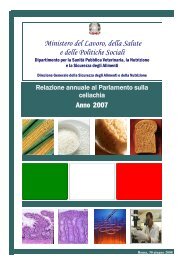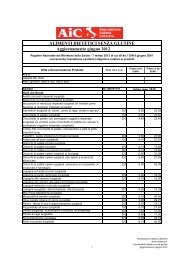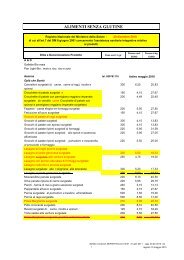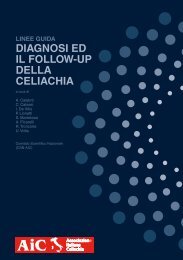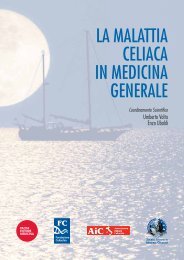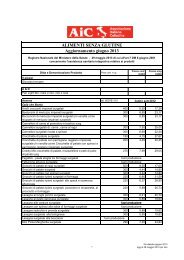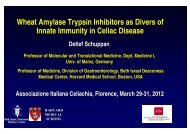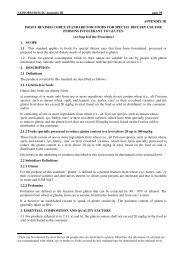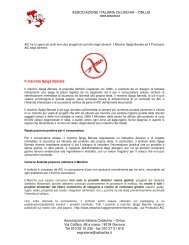primary prevention of coeliac disease - Associazione Italiana ...
primary prevention of coeliac disease - Associazione Italiana ...
primary prevention of coeliac disease - Associazione Italiana ...
Create successful ePaper yourself
Turn your PDF publications into a flip-book with our unique Google optimized e-Paper software.
COELIAC DISEASE IN THE SAHARAWI<br />
33<br />
ASP families, for instance in a consortium type study addressed to analyse all the CD<br />
ASP collectable worldwide on the order <strong>of</strong> 2,000 or more (ASPs). However, this<br />
strategy based on the analysis <strong>of</strong> very large sample sets <strong>of</strong> ASP families that have to be<br />
necessarily collected from different populations cannot provide a significant benefit<br />
regarding the confounding effects <strong>of</strong> genetic heterogeneity. An alternative approach<br />
could be to concentrate on an isolated population showing an high <strong>disease</strong> prevalence,<br />
to reconstruct all the relationships between the various affected cases and scan with<br />
parametric and non-parametric linkage tests the whole genome to detect non-HLA gene<br />
effects. It is likely that such a study design, already applied in the case <strong>of</strong> type 1<br />
13<br />
diabetes , would provide sufficient statistical power to detect significant results across<br />
the genome.<br />
The high prevalence <strong>of</strong> CD in the Saharawi population<br />
14<br />
CD is typically found in individuals <strong>of</strong> Caucasian origin . In Europe and North<br />
15-16<br />
America the <strong>disease</strong> prevalence is around 0.5-1 % <strong>of</strong> the general population .<br />
Recently a tenfold higher CD frequency (5.6 %) was reported in the Saharawi, a people<br />
<strong>of</strong> Arab and Berber origin with high degree <strong>of</strong> consanguinity, living in the Sahara desert<br />
17<br />
. We analysed the genetic association <strong>of</strong> the main CD locus in a group <strong>of</strong> Saharawi<br />
children affected with CD and their first-degree relatives. The aims <strong>of</strong> this study (which<br />
is described in details below) were:<br />
1) to evaluate whether the degree <strong>of</strong> association at the main <strong>disease</strong> locus was similar to<br />
that observed in other populations;<br />
2) to investigate how the frequency <strong>of</strong> the predisposing HLA molecules in the general<br />
Saharawi population relates to the high prevalence observed in this ethnic group.<br />
Patients and methods<br />
This work was performed on Saharawi refugees living in the camps near Tindouf,<br />
Algeria. Blood samples were collected with the informed consent from a group <strong>of</strong><br />
previously diagnosed subjects with CD and their first-degree relatives. The diagnosis <strong>of</strong><br />
CD was based on the finding <strong>of</strong> serum IgA class antiendomysium antibodies (EMA)<br />
positivity on at least two consecutive blood samples and, in a subgroup <strong>of</strong> patients, the<br />
17<br />
typical enteropathy at the small intestinal biopsy, as previously described . EMA were<br />
detected by indirect immun<strong>of</strong>luorescence on serum diluted both 1:5 and 1:50, using<br />
monkey oesophagus as the antigenic substrate (Antiendomisio Eurospital, Trieste,<br />
Italy). Patients were 79 subjects (33 males and 44 females) deriving from 69<br />
independent families, with a median age <strong>of</strong> 8 years (range: 2-37) and including 69<br />
probands, 8 siblings and 2 mothers. Overall 136 healthy subjects were also investigated<br />
with a median age <strong>of</strong> 30 years, range 2-70 years. These included 29 individuals from 9,<br />
non-CD, unrelated families and 107 first-degree relatives <strong>of</strong> the CD patients (53<br />
mothers, 17 fathers and 37 siblings). Additionally, in 12 parents <strong>of</strong> CD patients for<br />
which DNA samples were not available, the DQ genotypes were unequivocally<br />
deduced based on the available data from the other parent and the <strong>of</strong>fsprings.<br />
DNA was extracted using the chelex method starting from dried blood spots<br />
18<br />
(Guthrie cards) . Amplification <strong>of</strong> the polymorphic second exon <strong>of</strong> the HLA-DRB1,





